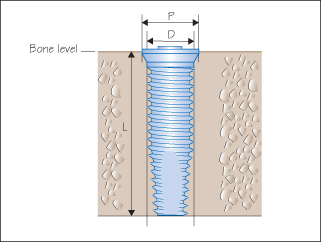6
Implant macrostructure: shapes and dimensions
Most screw-type implant systems are available in different shapes and dimensions. This allows clinicians to select the most appropriate implants according to the clinical situation (see Chapter 23).
Treatment planning in implant dentistry aims to maximize the implant surface in contact with the bone bed, to provide a good bone–implant contact (BIC). This surface increases with the length, diameter, and design of the implant, but also with the surface characteristics (see Chapter 8). Most of the time, an optimal contact can be obtained with a standard implant.
Another major goal of implant surgery is to achieve a good primary stability. In this view, numerous dental implants dimensions and designs are commercially available (Table 6.1).
Table 6.1 Commercially available dental implants
| Length (in mm) | Diameter (in mm) | |
| Minimum | 5 | 2 |
| Standard implant | 10 | 3.75–4.1 |
| Maximum | 20 | 6.9 |
Standard implants are well documented in the literature, and show excellent success rates in normal conditions, i.e. sufficient amount and a good quality of bone. In case of limited bone volume (height or width), an alternative to bone augmentation is to adapt the implant at the existing anatomy, through the use of narrow, short or wide implants.
Limited evidence is available regarding the impact of dental implant dimensions on the survival/success rate. Therefore, except for the standard dimensions, clinical guidelines are based on biomechanical theories confirmed (or not) by clinical trials.
Implant Length
The length of an implant can be defined as the distance from the most coronal part of the implant inserted into the bone, to the more apical part of the implant (Fig. 6.1). Most implant systems provide implant length from 4 mm to 20 mm or greater.
Figure 6.1 Implant dimensions. L, length; D, diameter; P, platform.

Long implants (more than 10 mm) are indicated in particular situations where primary stability requires an apical anchorage: immediate implant, bone def/>
Stay updated, free dental videos. Join our Telegram channel

VIDEdental - Online dental courses


